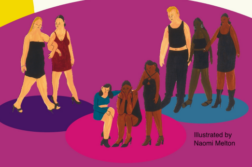TW: racial slurs
About 100,000 black GIs (Ground Infantry) were stationed in the UK during the Second World War as they waited to be called to action in France. About a tenth of all the US troops who came to Blighty were African Americans.
However, rather than being a unified force, there was a strict ideological and practical barrier between the black and white American soldiers who came here. Barracks and mess halls (canteens) were segregated by race. Some white GIs tried to tell owners to prohibit black people from entering pubs, theatres, and clubs etc. Black soldiers were always commanded by white officers, and they had no opportunity of promotion to a position equalling that of a white official because the white leadership thought they were inherently incapable. Between 1943 and 1944, there was an average of four violent clashes per week between white and black American soldiers.
In 1940, over three quarters of all black Americans lived in southern states where the ‘Jim Crow’ laws were in force. The legislation legalised racial segregation, and was enforced in areas of society including hospitality, housing, education and employment. They also prohibited African Americans from voting. Those who defied these laws faced arrest, imprisonment, and sometimes death. These laws existed for over a century, and were only formally abolished with the signing of the Civil Rights Act in 1964. The British government and military made no objection to the American troops maintaining these principles among their own, but they never emulated them, and the public was generally shocked by the practice.
The comments of one white American lieutenant shows the extent of the attitudes they held:
One thing I noticed here and which I don’t like is the fact that the English don’t draw any color line. The English must be pretty ignorant. I can’t see how a white girl could associate with a negro.
This kind of opinion is chillingly reminiscent to what we might hear from those like the National Front or the English Defence League, but such strict separatist views have never been the consensus of the British public as a whole. Britain was confused about how the Americans could be so intent on fighting Hitler’s racist fascism, but maintain segregation themselves.
In 1943, near Bamber Bridge in Lancashire, a scuffle broke out after a group of white military policemen tried to prevent black GIs from entering a pub. This led to a huge fight with the GIs and locals against the military policemen, in which seven men were seriously injured by bullets and broken bottles and one was killed. The incident was later coined the Battle of Bamber Bridge. As a result, 32 black servicemen were court-martialled (sent to military court), while the white participants were only reprimanded.
However, the key here is that the white locals of this small village decided to side with the black soldiers rather than the white ones – they just couldn’t accept the idea that those who were white could treat their black counterparts with such rampant racism. It is reported that in response to the white soldiers’ demands for segregation, the local pubs in Bamber Bridge posted signs in their windows saying ‘Black Troops Only’.
Walter White, an African American civil rights activist, said many black soldiers had, in England, ‘their first experience in being treated as normal human beings and friends by white people.’
There was a certain amount of resentment among British servicemen about the black GIs because they suddenly had to compete for female attention with muscular, charismatic, and well-paid Americans. But there is little evidence that this bitterness descended into genuine hatred except for a few exceptions.
White Britons welcomed the black soldiers into their leisure pastimes, as former black GI, Cleother Hathcock, recounts:
At that time, the Jitterbug was in and the blacks would get a buggin’ and the English just loved that. We would go into a dance hall and just take over the place because everybody wanted to learn how to do that American dance, the Jitterbug. They went wild over that.
As this was permitted by the British public, white American soldiers probably looked on in bemusement, as such mixing between races would never have been accepted in the US.
In 1942, Bristol Cathedral was full to capacity for a special service to mark Thanksgiving, with locals reportedly moved by the ‘negro choir‘. One incident in the city saw the landlord of the Colston Arms (named after slave-owner Edward Colston whose statue was torn down during a Black Lives Matter protest earlier this year – the irony is irresistible) refusing to eject two African American GIs on the demand of white soldiers. In 1943, a survey of the general opinion of Bristolians found that they had a positive view of their black visitors, with Bristol dockers saying, ‘they are not like we’ve seen them in the films … not stupid and dull.‘
An American journalist in Gloucestershire remarked on a visit to Britain that ‘negroes were welcomed with open arms on a footing of complete equality’ which they would have been far from accustomed to at home across the Atlantic. Their time in the UK was an eye-opening experience for many, which historians have theorised may have helped inspire the later American Civil Rights Movement.
This country is not exempt from racism. It’s existed here for centuries, and unfortunately, still does. But I feel a certain amount of pride that we welcomed the black GIs into our country all those years ago and appreciated their help in fighting the Nazis, instead of treating them as another enemy.



